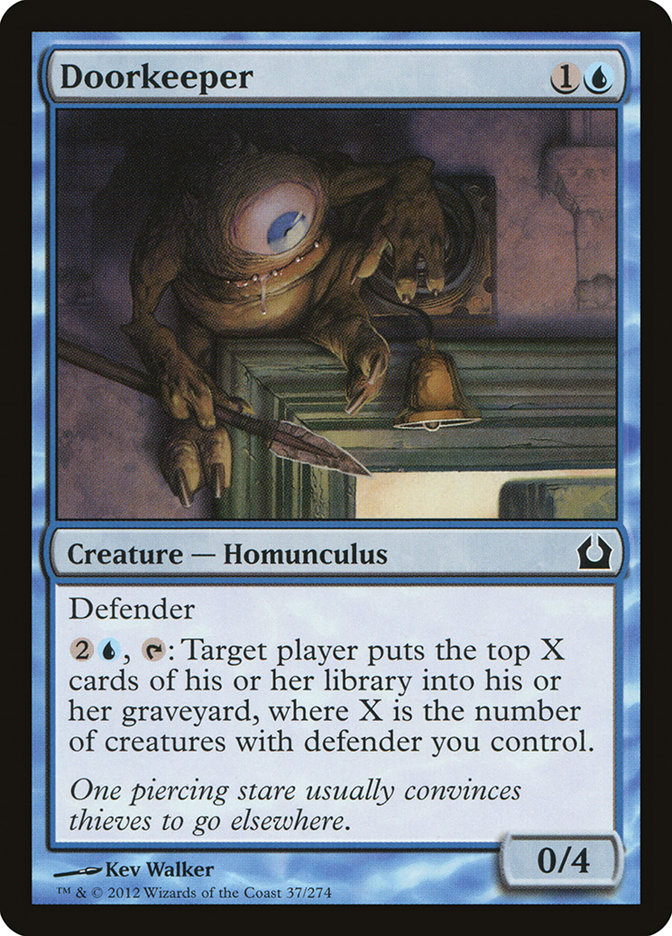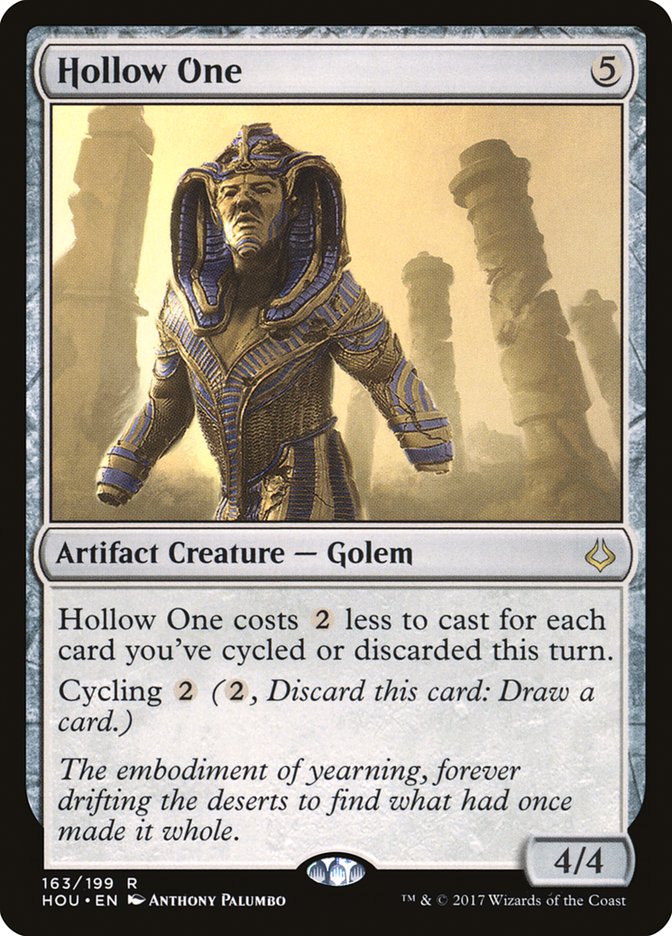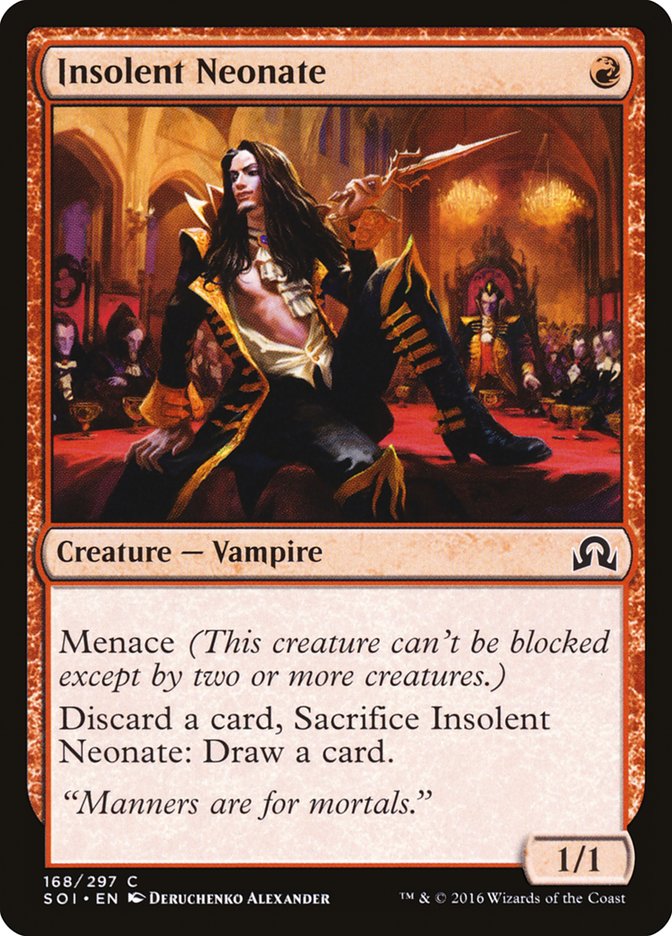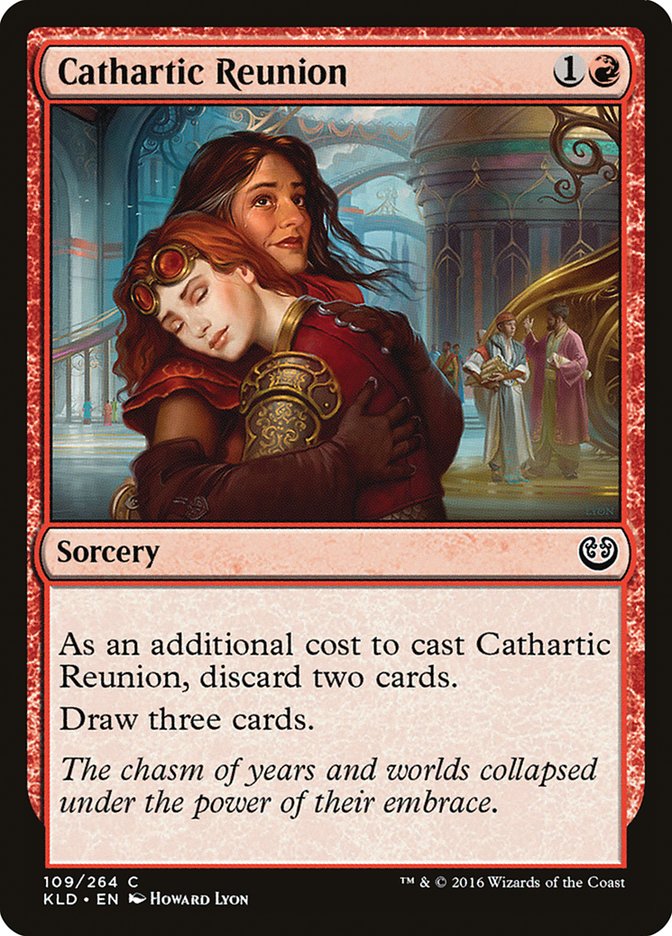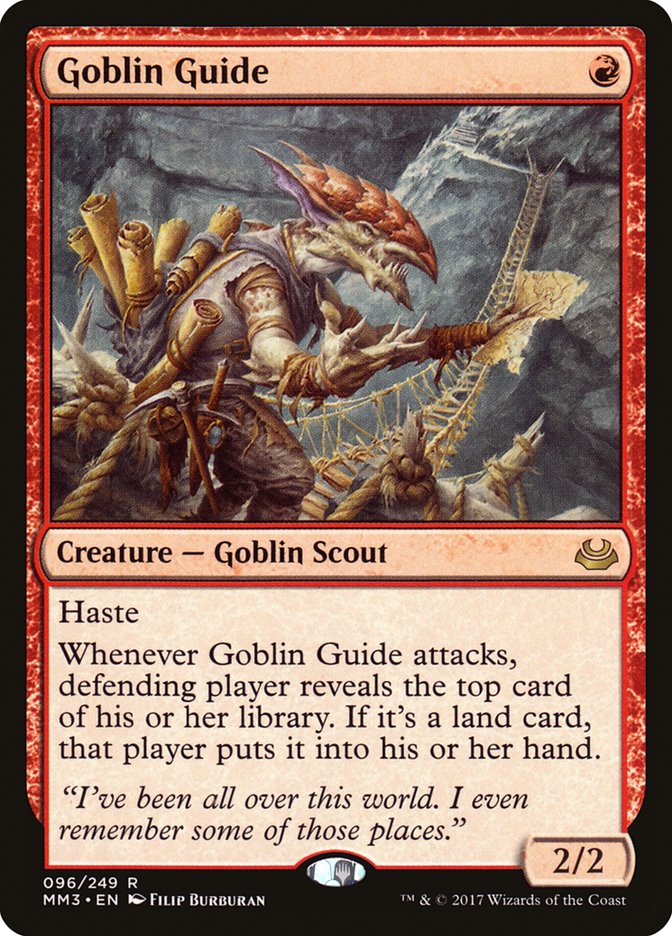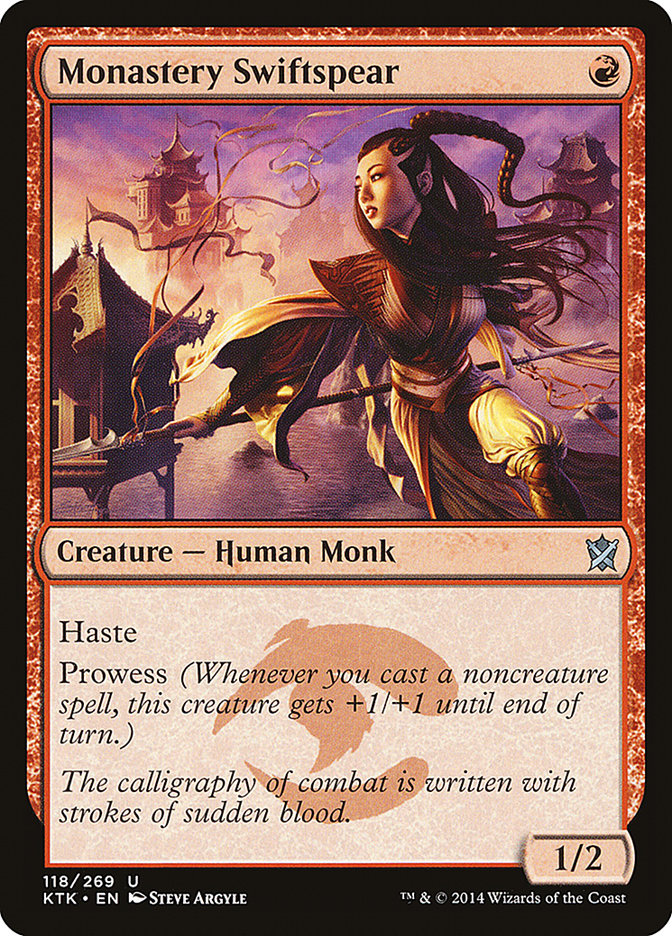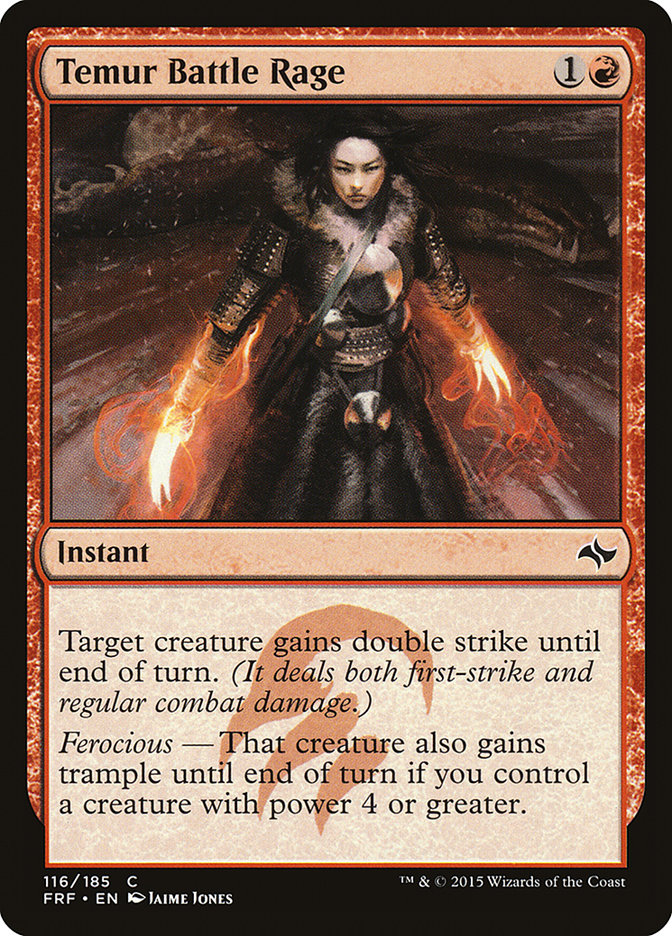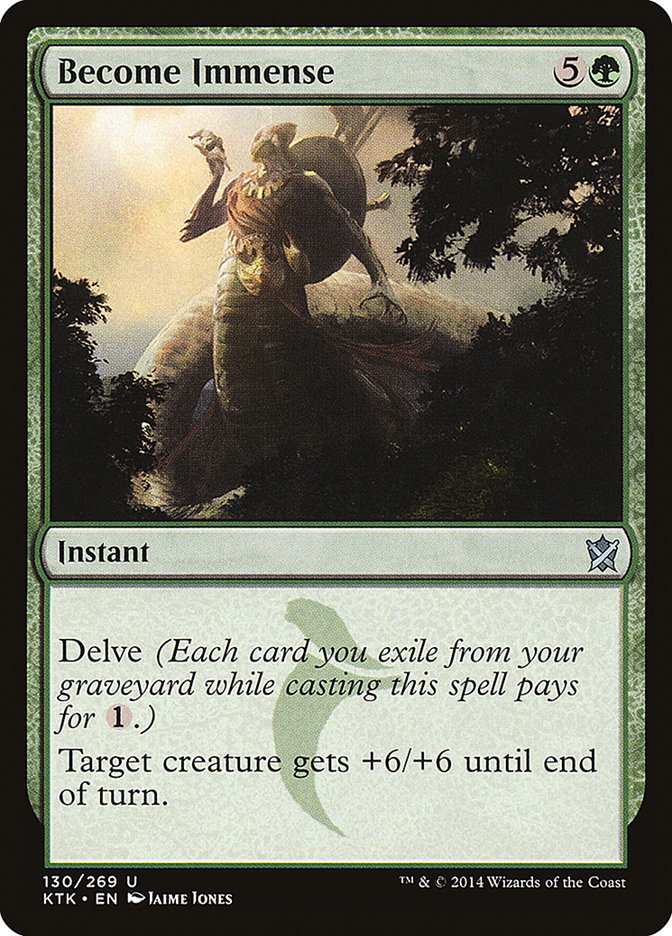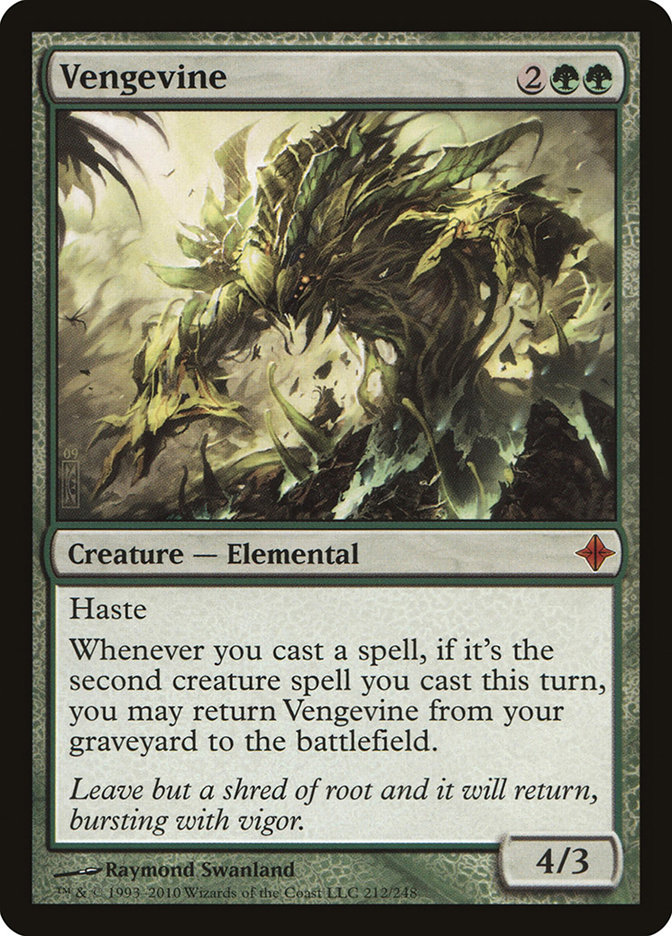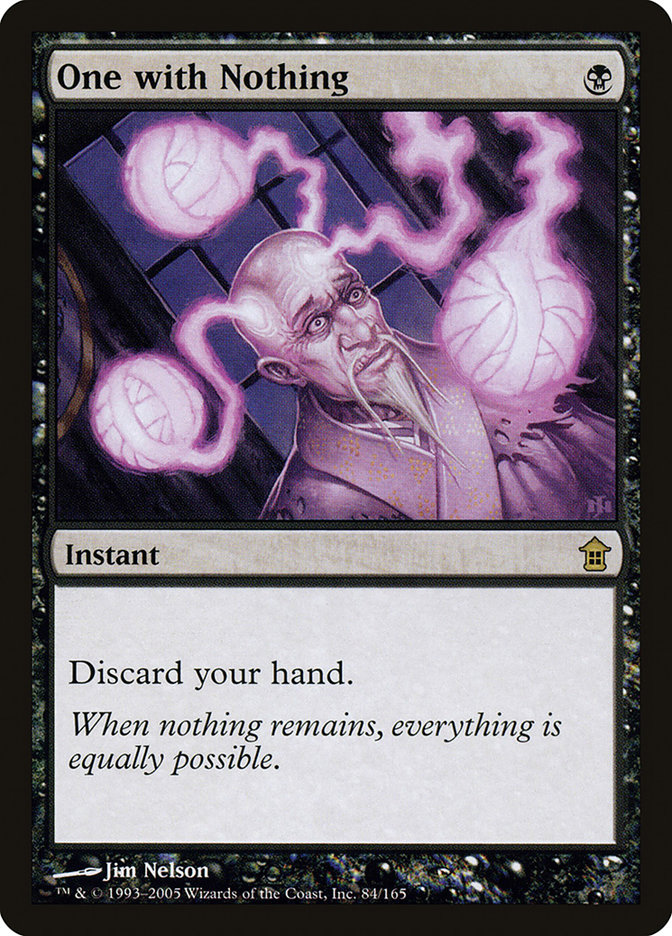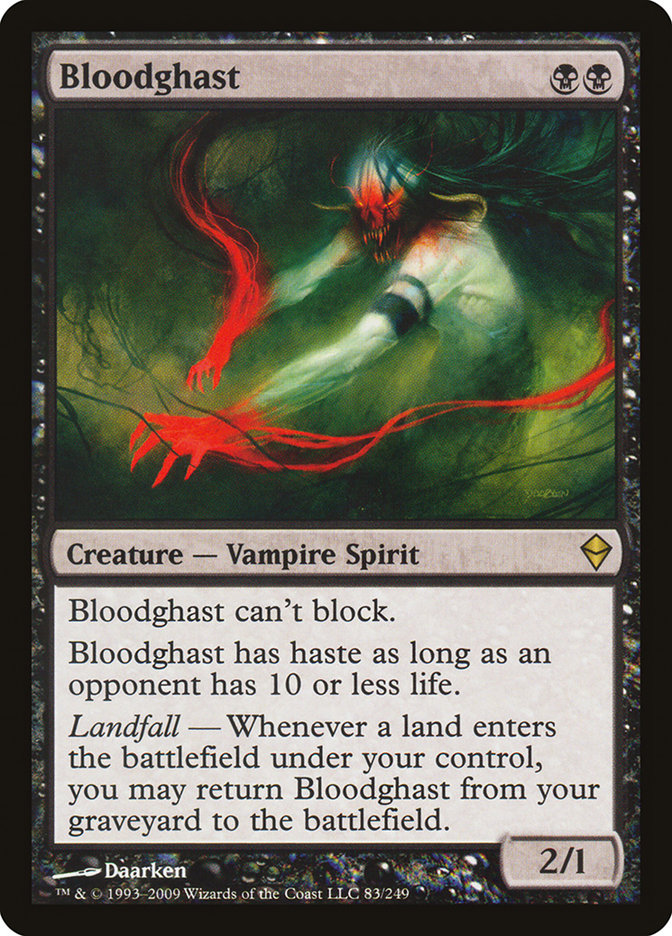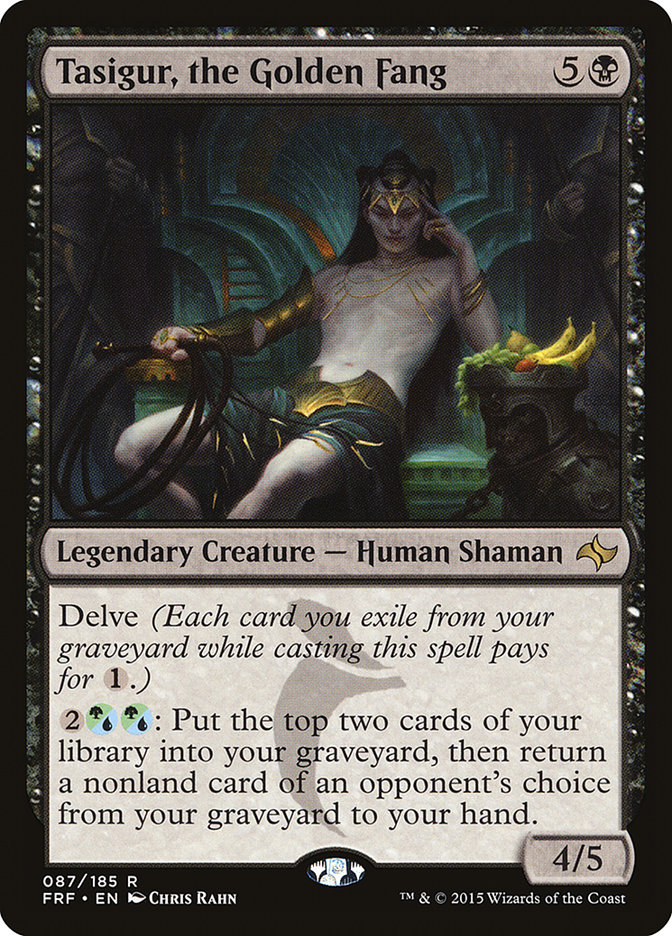Greetings, dear reader, and welcome to a rousing edition of McLaren’s Musings.
I, Shaun McLaren, will be your guide as I boldly delve (in this case both literally and figuratively) deep into what gifts Magic has to offer. I will risk life and limb, or at least dice and limp, to find and play the most innovative new decks and share my findings with you.
Bravely I will venture forth and test new possibilities.
Fearlessly I will leap forward to explore the uncharted.
Gallantly I will play hopscotch with the unknown.
Now that I’ve finished hyping myself up, let’s begin… actually I should probably hype myself up a bit more.
Sleek, efficient, strength, horse-power, maneuverability, four-wheel drive. All of these things not only describe a car, but also yours truly. And truly, I’m yours.
“So We’ll Just Be Going…”
Not so fast!
I now stand between you and the door.
Today I’ll be reviewing a brand new deck in Modern: R/G Vengevine.
Actually, scratch that… Today I’ll be experiencing R/G Vengevine. As you know, a distinguished deck connoisseur doesn’t just play Magic; they embrace it, face first.
Julian Grace-Martin, who piloted the deck to #SCGNY, has a fitting name, since it’s an act of grace that a new deck should arrive in Modern that not only titillates and inspires the senses while being able to compete with Tron lands and Death’s Shadow.
Let’s begin with the decklist:
“Fine, Show Us the Deck.”
Creatures (25)
- 4 Street Wraith
- 3 Goblin Guide
- 4 Vengevine
- 2 Hooting Mandrills
- 4 Monastery Swiftspear
- 4 Insolent Neonate
- 4 Hollow One
Lands (18)
Spells (17)

It’s as though Mono Red and a Dredge deck had an intimate encounter and nine months later this deck was born.
Hollow One all but appeared to be empty of any value… until now.
The basic premise of the deck is pretty basic, but let me explain anyways, since not everyone can grasp the essence of a decklist at a glance.
You draw with Faithless Looting, Insolent Neonate, and Cathartic Reunion and also use them to discard Vengevine. Then you cast Hollow One for cheap or free after discarding cards and return your Vengevines from the graveyard to the battlefield.
Simple enough. In reality, a deck with Faithless Looting and Cathartic Reunion actually has a lot of difficult decisions to make when you aren’t just happily discarding Vengevines and casting multiple Hollow Ones for free.
The core of the deck is solid and powerful, but I wonder there’s enough meat for it to function properly? I’m worried some of the supporting cast members aren’t ready for prime time.
Goblin Guide seems a little out of place to me, although I’ll admit it’s not a card I’m generally a fan of. The nice thing about it is you’re an aggressive deck, and it’s a one-drop, which helps bring back Vengevine. The issue is you often don’t want to be casting it turn 1, since you’ll want to be saving enough creatures to return your Vengevines once you discard them.
Monastery Swiftspear, Temur Battle Rage, and Become Immense all work together and form a cohesive unit, and they can steal wins and support your good draws, but they probably won’t win you many games purely by themselves.
Lightning Bolt is a great card and good interaction, but you don’t see a deck like Dredge, which is ultra-focused around its core strategy, running Lightning Bolt, because it doesn’t help its main gameplan. But maybe they’re just aren’t better options, and you have to hope you don’t draw your “Plan B” side of the deck too often.
How does the deck actually perform?
Well there’s only one way to find out, so let’s move on and see what the deck is capable of. If you need to take a bathroom break, I suggest you do so now, because the real gameplay images you’re about to see are bladder-emptying-ly shocking.
“What? Maybe We Shouldn’t Look at the Cards…”
Look at the cards!
Boldly I set out to try and play the deck online, but I immediately hit a snag. It seemed something had raised the price of Vengevines and Hollow Ones recently. Vengevine was merely a couple of tickets just hours ago, and now it was upwards of five! What a strange coincidence…
“You had years to pick me up, pal.”
But I was willing to suffer, and pay any price, no matter how steep, no matter how high, for you, dear reader.
“Uh…Okay. Thanks?”
Do not weep for my sacrifice!
I purchased the cards I was missing and was ready to play.
Invigorated by overcoming my first exciting obstacle of getting the cards, I dove into a match.
This was the result of my second turn after first trying out the deck:
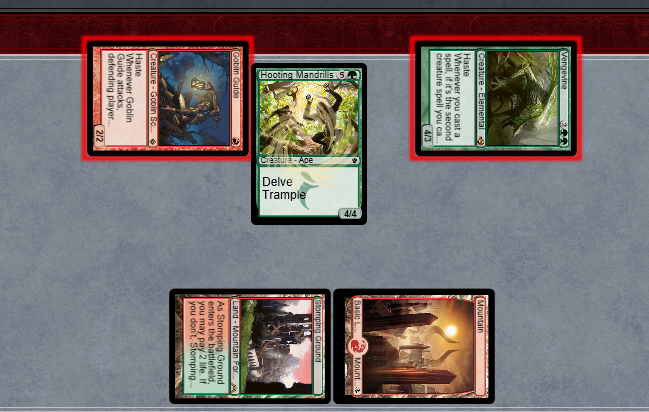
Amazing. The euphoria of having ten power on the battlefield by turn 2 is indescribable.
I can only imagine it pales in comparison to holding your newborn baby, but I’d have to go find your newborn baby to test it scientifically first.
Not a bad first taste, but this Venge-fine deck had only offered up an entree salad. I was ready for the main course. Surely it wouldn’t be able to sustain such an incredible…
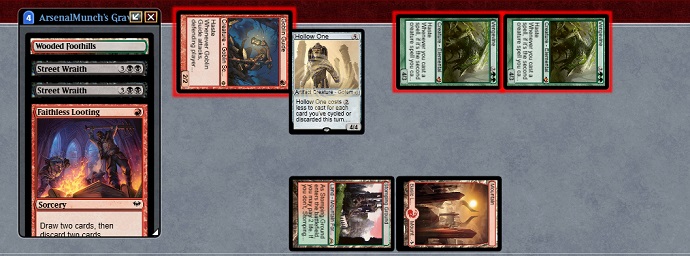
This was my turn 2… of my second game with the deck.
Oh my!
I thought the good times would never end.
Spoiler alert: they did.
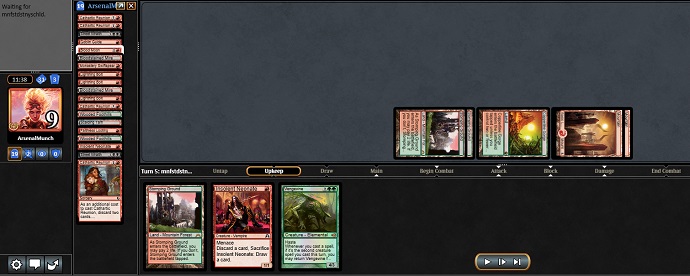
So what happens when the deck doesn’t draw Hollow One or Vengevine?
This is what happens when you go through nearly half the deck and don’t find a Vengevine or Hollow One.
My immediate downfall was almost poetic.
I had thought that this deck was the deck to beat all other decks. That it was full of hope and wins. But it turned out to only appear that way on the surface. Digging inside only revealed that the deck was hollow, like its namesake card.
The deck depends more on drawing Hollow One and Vengevine than Gotham City is on keeping the Bat-Signal plugged in.
Building a deck around Hollow One? A five mana 4/4? Really?
Why did I ever get my hopes up? Why did I think I’d never lose again? Why did I put my happiness, hopes, and dreams on the outcome of a game of Magic? Why was I being so overdramatic and tilting so hard after one loss?
Suddenly I had become the Hollow One.
Just read its flavor text:
The embodiment of yearning, forever drifting the deserts to find what had once made it whole.
It was winning that had once made me whole, and once that was taken away, I had become One With Nothing.
I’m a big enough man to admit that I curled up into a ball and wept when I lost my first game with the deck. It takes a mature human to admit they’re immature.
“Okay, Then. So, We’re Going to Go Read Sam Black’s Article…”
How could the universe be so cold and uncaring?!
I had a hollow feeling inside…
Was I dying?
But then I realized it was only a game and I was taking things way too seriously and that the over-emotional complainer bit was getting old.
I had to fight back.
I had to try not to die, harder, and with a vengeance.
A Vengevine-ance.
Behold: the turn 1 dream.
And once again all was well.
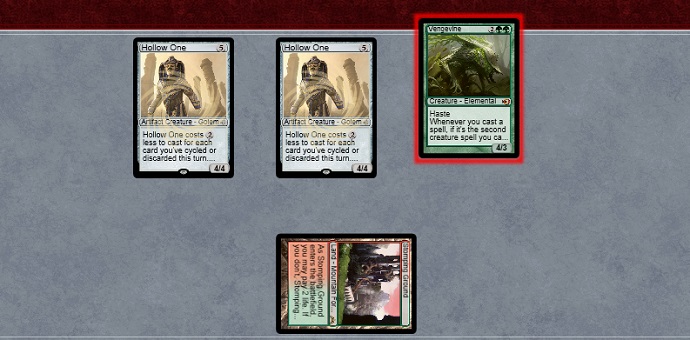
But were the good feelings I had only about winning? Would they just disappear when I was losing again?
Then I had a flash of insight. The meaning of the universe revealed.
It’s not about winning or losing, all the time. It’s about having completely ridiculous and busted draws some of the time.
Thank you, R/G Vengevine, for teaching me such an important lesson.
Pros! (Yay!)
- Nut draws.
- Fun, unexpected, and powerful.
- Vengevine and Hollow One!
Cons… (Boo…)
- Terrible do-nothing draws.
- Backup plan is lacking.
- Domri Rade.
“Just Give Us Your Tweaks So We Can Leave.”
A true master can improve upon a deck after playing a few matches with and build a completely new version with no testing whatsoever:
Creatures (28)
- 2 Grim Lavamancer
- 4 Street Wraith
- 4 Bloodghast
- 4 Death's Shadow
- 4 Vengevine
- 2 Tasigur, the Golden Fang
- 4 Insolent Neonate
- 4 Hollow One
Lands (20)
Spells (12)
Sideboard

A Shaun-noisseur of fine decks like me has a couple humble Shaun-ggestions to improve the deck.
Naturally, your first instinct should be to jam Death’s Shadow into every deck you see, but you can’t just call it a day there.
I like the idea of Thoughtseize, not just as a Death’s Shadow enabler but as a nice turn 1 play that can strip your opponent of ways to interact with your graveyard.
We also have Bloodghast as another card we want to discard, and you can just cast it on turn 2 or later to return Vengevine occasionally in a pinch.
Ingot Chewer also seems like a nice option that not only works as artifact removal but can help bring back Vengevine for one mana as well.
Tasigur, the Golden Fang is basically just Hooting Mandrils in the deck, but it’s possible the deck wants to go back to embracing green mana more anyway, which would make Tasigur better.
“We’re Afraid to Ask, but…Anything Else?”
Finally, to get the full experience out of a deck, you must taste the cards. Like, actually eat them. A good deck should leave you craving more, enough to actually eat the card. (Disclaimer: do not actually eat the delicious, delicious cards.)
It may have just been my imagination, but there was the distinct aftertaste of seaweed from eating Vengevine and Hollow One was not very filling.
Not bad.
The Final Rating: 38/60
Overall, I rate R/G Vengevine 38 playables out of a possible 60.
The deck succeeds as a graveyard deck with occasional nut draws, but it also has some weaker cards that don’t help the core strategy and is also susceptible to draws that don’t do anything.
Thank you for reading, if you enjoyed this style of review (or not), let me know, and I’ll see you next time!


